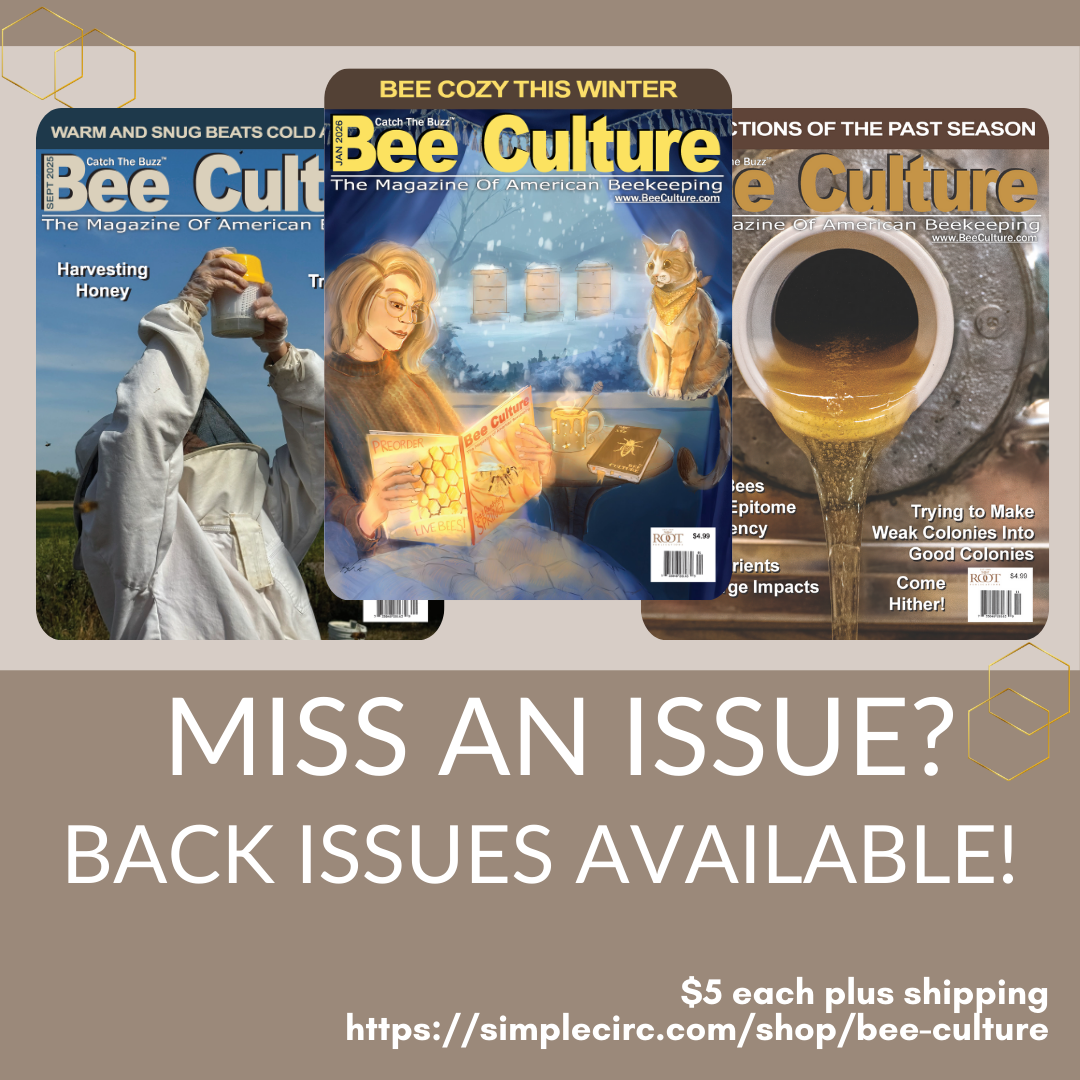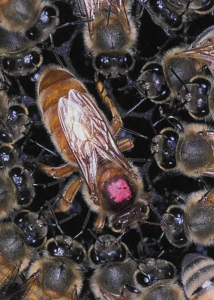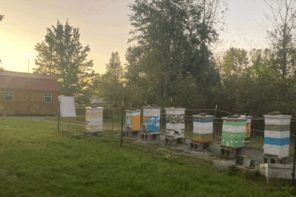By: Morris Ostrofsky
This article originally appeared in the Autumn 2017 issue of BEEKeeping Your First Three Years
The queen is often referred to as the “queen mother” because indeed she is the mother of all the bees in the colony. When we think about the role of a queen, we think about her as the decision maker within the colony. She is the morale glue that connects. She produces the young that supports the colony. Yet many “decisions” she appears to make are not hers alone. In reality she serves the workers who determine the length of her reign, when to expand, the gender and quantity of eggs she will lay. This article explores the relationship between the queen and her “subjects” as well as points out examples of queen related mellifera mysteries.
So who is the queen mother and what does she really do? Not all fertilized eggs are destined for royalty. Any fertilized egg has the potential to become a queen. The queen and workers are structurally the same except in the queen’s case she has functioning reproductive organs. The difference in their developmental path occurs on day 6 of her life or 3 days after she hatches from an egg.
This difference is the result of a number of factors. The queen cell size is larger than worker or drone cells. The cell orientation is vertical and the quantity and quality of food is greater than that fed to workers. During the next 5.5 days (days 4 to 8.5) the queen larvae are almost constantly fed a rich diet of royal jelly. Workers, on the other hand, are raised in smaller cells and are fed royal jelly only for the first 3 days of their larval period. Once the queen completes her development of approximately 15-16 days, she goes on multiple mating flights and settles down to a routine life of just laying eggs. She can lay about 1000 eggs per day and roughly 200,000 eggs per year over her lifetime.
One of the queen’s first activities, even before emerging from her queen cell, is piping. This is a rarely noticed series of sounds made by a queen. It has been described by A.I. Root as “a sort of zeep, zeep, zeep, zeep. It consists of a prolonged tone, or a long zeep followed by several much shorter ones.”
There are two forms of piping: Tooting is an amazing phenomenon produced by a queen that has recently emerged from her cell. Quacking, a similar sound but more muffled, is produced by queens that are about to emerge from their cells. Virgin queens, who usually run throughout the hive, will stop running when they pipe. They hold onto the comb, press their thorax to the comb and vibrate their thorax muscles. The sound this creates travels through the comb and is “heard” through the bee’s feet. The sound of piping is loud enough to be heard by beekeepers a few feet away from the hive.
Why do queens do this? The piping possibly serves as a warning to prevent multiple virgin queens from emerging simultaneously. And how the workers fit into this? They key into the sound of the queens quacking inside their cells. Short term the workers prevent multiple queens from simultaneous emerging by physically keeping queens in their cells when feeding them. A video with sound can be heard at the following site. https://www.youtube. com/watch?v=xK8fEPsAc6U.
After her exoskeleton hardens at about 5-6 days after emerging, the queen will take multiple mating flights to drone congregation areas. She does this when the weather is clear, not windy, and the temperature is about 69 degrees F. Mating takes place about 20 – 50 feet in the air. She will mate with approximately 12 to 20 drones. The result of successful mating is a supply of spermatozoa that is stored and viable for the rest of the queen’s life. 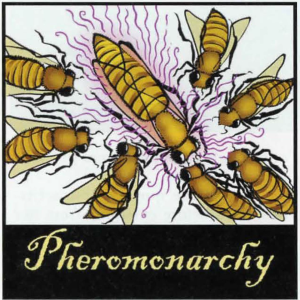
There are three mellifera mysteries associated with mating. How do drone congregation areas (DCA) form in the same location year after year and how do the virgin queens know where to find them? How do the spermatozoa remain viable for well over a year is the third mystery.
Drones gather in specific locations where they hang out waiting for a virgin queen to visit. These DCA are smaller than an acre, and persist year after year. In England, for example, DCAs have been documented in the same location for hundreds of years. The mystery is how do the drones know where to congregate? Almost all drones in a colony are gone by the end of Winter. Since the life span of a drone is 6-8 weeks, new drones could not possible know the location of the drone congregation areas from one season to the next. The answer remains an enigma.
Drones from a particular hive will fly about half a mile from home to a DCA. The virgin queens will fly about 2 miles from home. This separation of distance prevents inbreeding amongst the bees. How the queen locates the DCA remains to be discovered. Like the drones she has no memory of these locations.
One of the many fascinating queen abilities is gender selection of the eggs she lays. If she wants to produce a drone she lays an unfertilized egg. A worker on the other hand is produced by laying a fertilized egg. How she controls this internally and how she keeps the spermatozoa viable during her entire life is another mellifera mystery. What is known is how the workers influence her decision. Workers will build either large drone size cells, or the smaller worker sized cells depending on what is needed in the colony. When a queen approaches a cell in which to lay an egg, she measures the diameter of that cell with her front legs and then lays an egg of the appropriate gender. So, even here, a decision you would think is entirely up to the queen, is not. The workers are getting the first word on gender control.
The queen is essential to the functioning and homeostasis of the colony. She represents the main regulating factor of the colony functions. “This regulation is largely achieved by means of pheromones, which are produced by different glands and emitted as a complex chemical blend, known as the “queen signal.” Maintenance of worker cohesion, suppression of queen rearing and inhibition of worker reproduction are some of the effects of the queen signal. The queen’s chemical signal is passed among the bees by means of contact; touching as they move through the hive and by passing food to each other.
The presence, level or absence of the queen’s pheromone bouquet is key to the actions the workers take regarding construction of new queen cells: when a queen is old or sick (low pheromone signal), has disappeared or is dead, or the colony has become so congested that her pheromone signal is diluted. In each case it is the workers who make the decision. Swarm, supercedure and emergency queen cells are the workers’ response to these conditions.
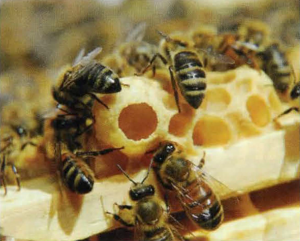 Swarming is the natural way that bees propagate new colonies. When there is a lot of food coming in and the colony population is increasing to the point of being overcrowded, the queen pheromone is spread thin. At this point the workers start preparing to replace the queen. Although swarming is the way colonies reproduce, a colony with young queen less than a year old is less likely to swarm. The colony with a new queen needs to build up its stores for Winter; they would not have time to recover and prepare for Winter if they swarm late in the season.
Swarming is the natural way that bees propagate new colonies. When there is a lot of food coming in and the colony population is increasing to the point of being overcrowded, the queen pheromone is spread thin. At this point the workers start preparing to replace the queen. Although swarming is the way colonies reproduce, a colony with young queen less than a year old is less likely to swarm. The colony with a new queen needs to build up its stores for Winter; they would not have time to recover and prepare for Winter if they swarm late in the season.
Swarm preparation starts with a queen cup. A queen cup is an inverted, empty cuplike structure usually found on the margins of the brood comb. The workers build queen cups any time during year but they only follow through and make a complete queen cell under certain conditions. Often new beekeepers will mistake a queen cup for a queen cell and assume their hive is about ready to swarm. A queen cup by itself means nothing and in most cases is never used. Once an egg is laid in a queen cup, the metamorphosis to a queen cell begins. Here is the next mellifera mystery. Does the queen voluntarily lay an egg in a queen cup or do the workers direct her to one? It’s just not known.
As soon as an egg is deposited into the queen cup, the workers enlarge it and it becomes a viable queen cell. These cells are referred to as swarm cells. The workers usually have a back up plan and build more queen cells than they need; approximately twenty. When the swarm cell is capped (plus or minus one day), the existing, old queen leaves the mother hive with roughly 50% of the workers and a small proportion of the drones.
Workers have a say regarding how long a queen remains on her throne. When a queen is perceived to be weak or damaged, the workers will replace her. This natural replacement process is called supersedure.
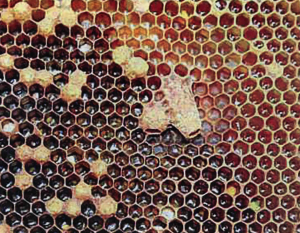 A queen’s peak egg production is in her first year. Beyond that time her egg and pheromone production becomes diminished. Another cause for replacement is the bees’ perception of damage to the queen; for example a missing leg due to a beekeeper’s manipulation, intentional or not. The jury is still out on whether or not wing clipping leads workers to supersede a queen.
A queen’s peak egg production is in her first year. Beyond that time her egg and pheromone production becomes diminished. Another cause for replacement is the bees’ perception of damage to the queen; for example a missing leg due to a beekeeper’s manipulation, intentional or not. The jury is still out on whether or not wing clipping leads workers to supersede a queen.
To make a supersedure cell the workers modify existing cells that contain 24-36 hour young larvae. Supercedure cells can be distinguished from swarm cells in a number of ways. They are usually found on the face of the comb and are darker in color. There are fewer supercedure queen cells than swarm queen cells. Sometimes a recently emerged supersedure queen will work side by side with her mother, the old queen. However this two queen situation does not last very long. The old queen disappears soon after the new queen begins to lay eggs.
If the queen is suddenly no longer in the hive, the lack of her queen pheromone causes an immediate reaction by the workers. They will modify existing cells containing young larvae and produce emergency queen cells. These cells can be distinguished from other queen cells in that they appear to be melted or fused into the face of the comb. Emergency queen cells are not built under optimum conditions. The workers may not have access to larvae less than 36 hours old. This can result in a queen that is inferior.
Despite the queen’s role as the perceived head of the colony, there are many reasons to believe she is not an absolute ruler. The question is does she rule or is she ruled? Most behaviors in the hive are initiated by her daughters. Like the queen of England, the queen bee reigns but does not rule.






